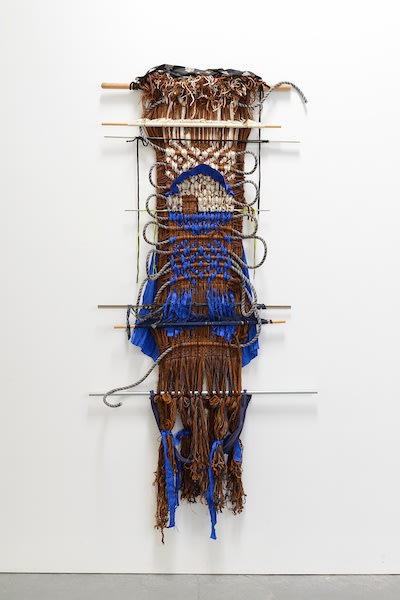Kira Dominguez Hultgren, a Bay Area-based textile artist whose multicultural background is represented in her work, takes an anthropological approach in her weaving. Not only is her woven work indicative of her family’s cultural history, it also reveals themes of identity, colonialism, evolution, migration, and exoticism. Dominguez Hultgren focuses her work on the global migration of textile patterning, which is internalized by the history of her family’s migration.
Dominguez Hultgren’s grandmother, Lawhaii (Kikume) Johal, was born and raised in Hawaii. Although she was the daughter of a half-Black, half-White mother and an Indian father, she grew up believing she was native Hawaiian and culturally performing as such, often by wearing flowers in her hair suggestive of hula girls. This identity was partially shaped by Lawhaii’s uncle Al Kikume and mother Whakaii Kikume, who both acted in Hollywood films as embodiments of native Hawaiians. Yet, it is arguable whether their manifestation of native Hawaiianess is authentic or simply the product of colonialism.
Offscreen, Al Kikume changed his original last name, Gozier Jackson, to one that sounded more Hawaiian. Records on the U.S. Census sheet also show Kikume’s “Color or Race” selection crossed out twice—first marked as “Neg” for Negro and another time possibly, but unclearly, marked as “Fil” for Filipino. Either way, both crossed out selections with no alternative suggest a negation of his racial identity. This further leads Dominguez Hultgren to question if Hollywood is responsible for authoring her uncle and grandmother’s Hawaiian identities.
Exemplified by Lawhaii (Kikume) Johal and Al Kikume, different cultural identities are perceived, performed, represented, and consumed in various ways depending on the individual. In the subsequent generation, Dominguez Hultgren’s mother, Lakshmi Johal Dominguez, was selected to represent India in the opening ceremony for It’s a Small World in 1966. Not only did she ride in the first boat with Walt Disney as part of the ceremony, but she and her sisters also rode elephants in a parade at Disneyland in the early to mid-1960s. To presumably white Disneyland executives, Dominguez Hultgren’s mother and her sisters epitomized India and Asia in their parades and events, hence the exhibition’s title, I was India.
Dominguez Hultgren describes her grandmother as “Hollywood Hawaiian” and her mother as “Disneyland Indian” (Dominguez Hultgren 2019) while questioning her own cultural identity. Her role as a weaver, however, provides Dominguez Hultgren with the opportunity of figuratively weaving “generational ends and beginnings…reinventions and redeterminations” (Dominguez Hultgren 2019).
I Was India: Embroidering Exoticism includes six woven pieces by Dominguez Hultgren—each representing her elaborate family history by including a range of mediums. Using two Punjabi phulkaris (embroidered pieces historically worn with traditional clothing) embroidered by her aunt Dalip Kaur (Johal) Bains in 1925 as her starting point, Dominguez Hultgren is able to add her own voice to her preexisting family history—a history that was somewhat covered through exoticism. She is not only resurrecting her aunt’s traditional work but also starting a map of her family’s migration.
With one such piece, Horizon Lines, Dominguez Hultgren weaves together her grandmother’s Punjabi suit and a Punjabi suit from her own childhood. She refers to this style of weaving as “discontinuous warp-faced weaving” (Dominguez Hultgren 2019). The two fabrics are attached at a midpoint with clear ends. However, where her grandmother’s story ends, Dominguez Hultgren picks it up. Her weavings are assembled constructions of identity that do not conform to a given space as they vary in size, do not often hang easily on the wall, and, depending on the piece, are sometimes placed on the ground. Rather, her nontraditionally shaped work is meant to be held up in non-neutral spaces, where the themes prevalent in her work are able to be openly presented and understood. Her work consists of pieces that are interventions of different weaving styles, patterns, and fabrics that explore cultural identity, colonialism, migration, and exoticism.
Shilpa Shah is a graduate student at San Jose State University pursuing her MA in Applied Anthropology. She is also an intern at San Jose Museum of Quilts & Textiles working closely with curators Amy DiPlacido and Samantha Lyons to develop a virtual exhibition in conjunction with Dominguez Hultgren’s on-site exhibition I Was India: Embroidering Exoticism.


